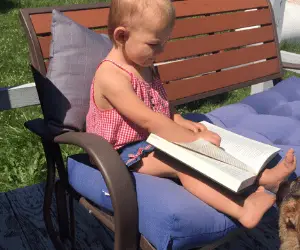
There’s several reasons why books don’t have ratings like movies. Movie ratings developed during the 37 years that film was not protected by the first amendment. There are more than 2000 times as many books published annually than the number of movies produced. Opposition cites fear of censorship. There’s a lack of funding and support for a rating system. Some insist that parents should monitor children’s reading and every reader should decide for themselves. There are independent rating systems for a limited number of books, but they don’t have wide spread support.
What purpose do movie ratings serve?
They protect children from inappropriate material and to provide shortcuts for parents to assess the thematic and offensive elements of a movie.
A fundamental underlying question is why does there need to be a book rating system? To protect children? For all ages to make informed decisions about their reading? As a short cut for choosing books?
The question remains: Why don’t books have ratings like movies?
Books Protected by the First Amendment but Not Movies
I found the history of the movie rating system fascinating.
A 1915 United States Supreme Court landmark decision firmly established that censorship could be applied to film. Mutual Film Corporation was a newsreel company that was getting annoyed by the fees and slow turn around time on what they could show and couldn’t show. They insisted that film should be protected under the First Amendment, freedom of speech, and should not be subjected to censorship. The Supreme Court disagreed. In Mutual v. Ohio Industrial Commission, Chief Justice Edward White wrote, “the exhibition of moving pictures is a business, pure and simple, originated and conducted for profit like other spectacles, and not to be regarded as part of the press of the country or as organs of public opinion within the meaning of freedom of speech and publication.”
The movie industry created their own organization, The Motion Picture Producers and Distributors of America to combat government censorship. They lobbied Washington for freedom to make the movies they wanted, at the same time they coached movie makers on how to stay away from objectionable material, eventually acting in collaboration with religious organizations.
In 1952, the Supreme Court reversed their decision and included movies in the protection of free speech and free press guarantee of the first amendment. But, by that time movie ratings were already part of the picture. They continued to evolve, expanding and changing as landmark movies came along to challenge the status quo, leaving us with the ratings that we have today (G, PG, PG-13, NC-17, R and X)
Just like the disastrous experiment of Prohibition, America eventually reinforced it’s commitment to freedom. At the same time, it surfaced the need for society to curb the most destructive elements of the culture.
Enough members of society were concerned about offensive content that limited information, in the form of ratings, are provided for people to make a more informed decision about the movies they watch.

There’s Too Many Books
More than 300,000 books are published annually in the U.S. according to information of the day’s website.
Wide circulation movies are released at the rate of roughly 130 a year. That means an influx of more than 2000 times as many books than movies.
The sheer enormity of the task makes it a logistical impossibility. On the other hand, if 30,000 people rated 10 books a year, it would be an easy assignment.
One idea is that the publishers themselves rate the books and give reasons for the rating. The big problem there is that makes the ratings biased and you don’t have any type of standard for comparing one book to another.
The Problem of Funding
Who’s going to pay the expenses for reviewers to rate 300,000 books a year? The book industry? Publishers and distributors? Consumers? Independent funding?
Ultimately, someone would have to pay the cost.
But, without book ratings, I think we’re paying the price, regardless. And the price is high.
In the movie industry, the movie makers themselves can absorb the cost of ratings into their budget.
Could publishers do that as well? They could. At least the big houses could. It might be a problem for self-published books, or those released by small publishers with limited resources.
Fear of Censorship
The National Coalition Against Censorship says, “book ratings are not such a good idea and would inevitably lead to censorship.”
According to the American Library Association,
“Librarians employ objective professional judgment through selection, cataloging, classification, and readers’ services to make available the information that library patrons want or need. Cataloging decisions, labels, or ratings applied in an attempt to restrict or discourage access to materials or to suggest moral or doctrinal endorsement is a violation of the First Amendment and Library Bill of Rights.”
So the battle over book ratings and censorship covers a much deeper issue: what are appropriate themes for kids and young people? What are we teaching our kids through our literature?
How can we help them develop the values that they need?
How can we protect the rights of the parents to teach what they believe is best, and not leave it to the educators and the government? Religious and sexual education are the responsibility of the parents. Educators and governments should not undermine beliefs taught at home and church.
Governments should protect the rights of the family and the church to educate children, not destroy those rights.
Some would argue that that’s not the case at all, that book ratings are just information in order to make a more informed decision. Some would call it a short cut.
I think it’s a valid point. Just because a book is rated for content doesn’t mean it’s singled out for censorship.
Some books aren’t appropriate for young children and weren’t written for them. Nadine Brandes, an author of YA books expounds.
Authors want to reach their intended readers. For me, that’s young adults and adults who like clean, but sometimes gritty Christian dystopian. I frequently tell parents, “I recommend my book for ages 15-and-up.” This helps readers know if the book might be for them. A parent isn’t going to give it to their 7-year-old (I hope.)

Belief that it’s the Parents’ Job to Monitor Kids’ Reading
Pre-reading everything a young person reads is a logistical impossibility, even for parents who really care and are in touch.
What if you have a voracious reader who’s 10 and one who’s 14? They don’t have a job or adult responsibilities. They want to read the hot new books that everyone’s talking about. There’s no way you can stay ahead of them.
There’s a lot to be said for free reading and letting your children choose their own books. But you can control the pond they fish from, even if they’re checking out books from school and the public library. You can also teach them to be discerning and show them how to find good books.
Granted there are plenty of kids who don’t have parents monitoring their reading. The parents are too busy, too preoccupied, too sick, working too much, too stressed, fighting addictions or just focused on survival instead of parenting.
Teachers, coaches, social workers, school counselors and administrators stand in the gap for at risk children. Sometimes they have the kids’ best interest at heart. Sometimes they don’t.

Book Ratings Exist For a Limited Number of Books
There’s been some momentum to create a national book rating system, but it hasn’t gained much support.
Karyn at Teach Beside Me started a petition in 2015 at change.org for the American Library Association to develop a national book rating system. The petition garnered 63 supporters before it closed.
Even though there’s not a universal rating system, there are some sites rating book content.
Common Sense Media currently has 5961 rated book reviews for kids and teens.
Rated Reads also has it’s own system which includes rated book reviews for kids and adults.
Compass Book Ratings is another site that rates the content of books.
There are other websites and book review blogs that also address the problem by including content ratings along with book reviews.
But these independent websites don’t use a universal rating system. Each one has it’s own.
Whose rating system are you going to use?
There’s so many variabilities associated with age and maturity levels. Choosing an arbitrary age for appropriate material is hard. Maturity doesn’t equal chronological age. Reading level often doesn’t correlate well with chronological age, either.
In spite of all the drawbacks of the movie rating system, it still serves it’s purpose and is reliable within it’s limitations. It works as a shortcut to watching the whole movie.
A book rating system gives you a shortcut so you don’t have to read through the whole book.

Trusting a Person Sometimes Works Better than Trusting a Rating System
I believe the scarcest commodity today is trust.
There are a plethora of book bloggers out there. They can give you the inside scoop of books without giving spoilers.
There is an advantage to following one person and going with their book recommendations. It comes down to an issue of trust. If you trust a person and agree with their world view, then you’ll be aligned with their values and the chance of their picks being winners for you is going to be high.
My top two people to trust for kids’ books are Sarah Mackenzie of Read Aloud Revival and Sarita Holzmann at Sonlight Homeschool Curriculum.
You can also check out my list of top picks for babies and for toddlers.
An independent list of recommendations, like Read Aloud Revival or Sonlight Curriculum works well for young children. They can’t buy books or check them out from the library.
But, at some point they will be able to choose their own books and obtain them for themselves.
Which leads us to the next question—
Should Books have Content Ratings Like Movies?
I say yes.
Information is not censorship.
If you’re a Muslim parent, you don’t want your children to be secretly indoctrinated as Christians.
If you’re opposed to the LGBTQ agenda, you don’t want your children to be secretly taught that it’s the only acceptable moral code.
Children’s books shouldn’t have hidden agendas.
Adult readers should not be blindsided by offensive content. It ruins the pleasures of the reading experience.
There simply is not enough time to personally preview every full length book out there.
We need the shortcuts of ratings.
And what happens without them? This is the danger I see.
The Problem of Hidden Agendas
Many people would like to impose their world view on all children.
This is a problem, no matter who’s doing it.
It’s a problem is LGBTQ activists are doing it. It’s a problem if Muslim activists are doing it. It’s a problem if Christian activists are doing it.
It violates our freedoms.
Most people don’t want someone else’s world view forced on their child.
Again, a violation of our freedoms.
If we truly believe in freedom of religion, then we can’t expect our beliefs to be tolerated and someone else’s persecuted.
You can’t have it both ways.
People shouldn’t be hiding their agendas in books for children and young people. They should be upfront about what they are espousing.
If you want me to give you freedom to believe what you want, then you need to extend that same courtesy to me.
Are you aware that book censorship has changed? Read my post Banned Books: How Censorship has Shifted, Why it Matters and What to Do About it.
Check out my top books for babies and toddlers by clicking here.

5 Comments on Why Don’t Books Have Ratings Like Movies?